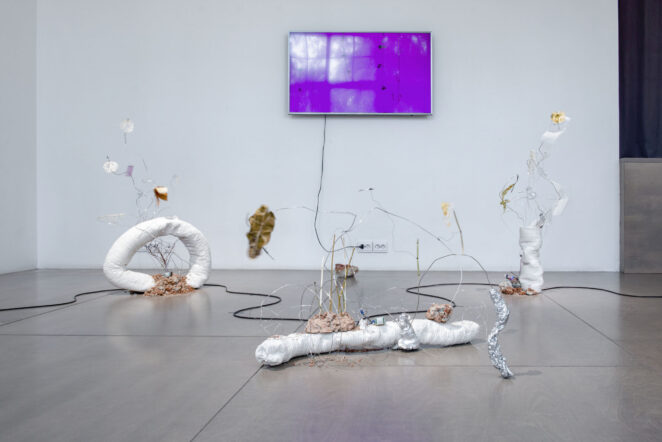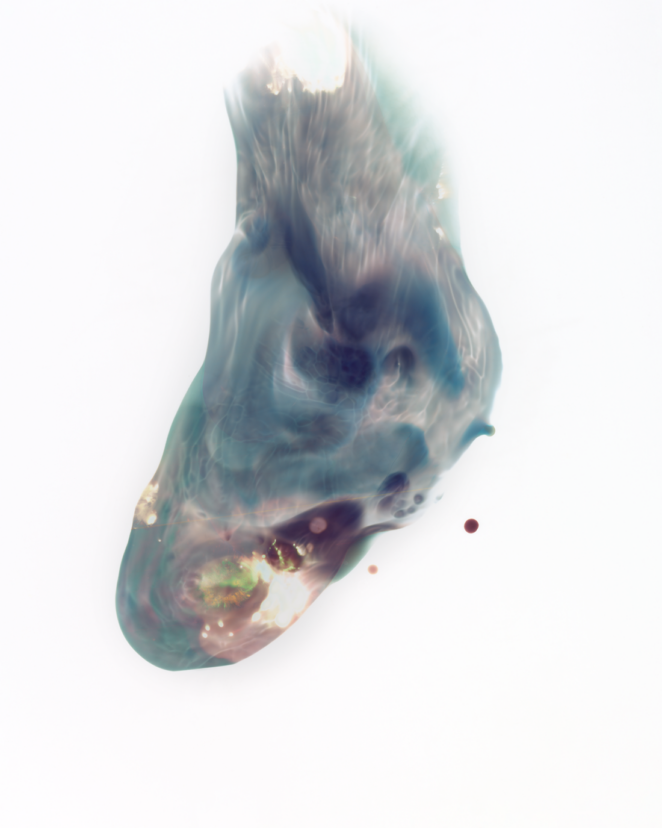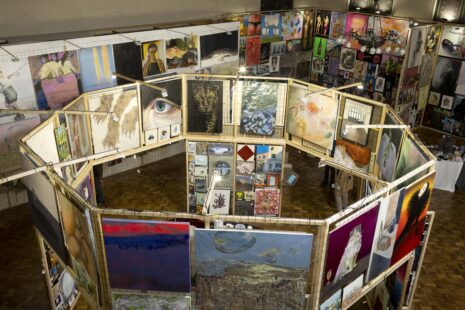First of all, congratulations! How do you feel about winning the Grand Prix of NBYAA – was it a surprise you won? What is important to you about the prize?
Thank you! It was such an unspeakably thrilling and unexpected surprise indeed. When I found out about this fact, me and artist Laimdota Malle, we were on our way to Ventspils to see the planned exhibition’s premises. We stopped at the gas station for a coffee. While I was waiting for her in the car, I looked at the news on Facebook. I saw that my master’s thesis reviewer and fantastic lecturer Mrs Helena Demakova congratulated me with the prize. She had managed to take a screenshot from Noar’s website with this news. I couldn’t believe it right away. I read the message slowly three times and kept thinking: no, it can’t be! I am very, very thrilled!
On the importance of the award. I have to say that I live in a lot of solitude, digging into my inner world, reading a lot and researching issues that interest me most. Lately, it is somehow got more towards existential topics. Engaging in a personal search for meaning. I am one of those personality types who feel very uncomfortable in the spotlight and shy away from attention.
The award serves as a valuable tool that allows me to work, strengthen my belief system, and broaden my horizons. The kinetic energy that prevents laziness. For which I am very, very grateful.
Your installation Orgatopia is a manipulative study about the resistance of plants. You created a video projection and six installations of biomorphic, kinetic hyperobjects. Please explain your artwork a bit – what inspired you in making it?
I started working on the issue of the interaction between the natural and the artificial state already in 2018 in the international master class “Sense of change” organized by International Summer School of Photography, led by a photographer and professor for photography at the University of the Arts in Bremen (Germany) Mr Peter Bialobrzeski. Since the dialogue between the idea and the chosen material is important to me, within the master class, I worked with the technique of photosynthesis, where I made contact copies on organic plant leaves using natural UV light from the sun. Later, when I started researching my master’s thesis, I knew that I wanted to continue this topic and maintain this state of artificial and natural change. I knew that the result should be based on a long process.
Slowly and consciously, a year before presenting the final work, I started testing techniques, formats and dealing with unnatural influences on organic structures to convey the intended sense of ecological anxiety in space. As for ideological impulse for the work, that came from Timothy Morton’s book “Hyperobjects. Philosophy and Ecology after the End of the World”. In this book, Morton talks about the concept of hyperobjects, meaning, such objects that refer to events and things in nature that are widespread in time and space concerning people. Those objects (hyperobjects) take up a large dimensional space and therefore are not visible for a long time. The hyperobject could be a biosphere or the solar system. A hyperobject could be the sum of all nuclear materials on Earth; or just plutonium or uranium. A hyperobject could be a very long-lived product from commercial production, such as foam or plastic bags, or the sum of all the swirling machines of capitalism. So hyperobjects are “hyper” to another entity, whether they are produced directly by humans or not. Hyperobjects have many common features. They are contagious, which means that they “stick” to the beings associated with them.
This notion of hyperobject that unleashed in my reflections on technological and ecological pollution, but in the context of the fact that nature has always learned to adapt and change. The only question is, how?
You study the topic of changes in the relationship between man and nature. What specifically inspires you in that topic?
I’m intrigued by Ann Tsing, an American anthropologist’s thesis that art can provide ideas, influences, and experimentation with the reality of a “living and damaged world.” Many of the projects on climate change and Anthropocene may be jeopardized because they are perceived only as artistic interventions in fundamental scientific issues. However, I agree that it is important to realize that time is the central, conceptual reference point of the Anthropocene, based on evolution and geological change. The question is what impressions this time leaves on our bodies and all the living environment surrounding us.
In my opinion, the same issue applies to the ethics and ecology of art objects and exhibitions. What materials and resources are being invested and whether they serve only to represent a short-lived idea, where the proportion of waste is likely to outweigh the public benefit.
When creating the work Orgatopia, one of my principles was to use the most environmentally friendly materials. When left in the open, they would disappear independently and quickly without harming the environment.
In my work, I need to be aware of my hypocrisy and ethics concerning materials and resources I consume or recycle for the sake of an idea.
How has the last year, 2020 that brought us a pandemic and influenced our way of living, influenced you, how you work and create art?
My lifestyle in broad strokes has not changed much. Since my everyday life is largely spent in solitude – reading, walking or working in the studio, I enjoy the uninterrupted time with myself. I miss thou exhibitions, some travelling and home depot store visits to explore and buy some materials (here, in Latvia, we have quite a strict lockdown rules). Our lives are online these days. I find it very interesting to observe this process when we, as humans, as organisms, are forced to isolate from each other. Our natural state changes and the interaction in the electronic space intensify. In a way, it can be said that the processes of adaptation and emotional fusion with the technological environment and electronic tools are initiated more than ever.

Has art and being an artist always been the only option for you? How did you find your way into the field?
Like Wassily Kandinsky and other artists in the past, before approaching art studies, I also wandered through a different path of knowledge, my bachelor’s degree is in law. However, I have not worked in this field a day. I come from a small town and not so wealthy family, so after high school, my first impulse and encouragement from parents were to look for a job and an education that could provide a steady income. So, I did it for a while.
Interestingly, I remember, my mother had an unfulfilled dream of playing the piano, so she thought that it should be realized through me – basically forcing me to go to music school. I had trouble to focus enough, and I was terrified most of the time, so nothing good came out of it. Recently, when organizing my desk, I found that Soviet-era certificate, which was bureaucratically printed in a way to cover both: art and music school fields, which meant that the excess area was strikethrough. So, art, in my case, after graduating from music school, was crossed out. It was a quite strange feeling to look at it after such a long time.
It so happened that as time went on, I gradually began to return to myself and to what was very important in high school – to be creative, to think through form and content. I started with photography as a medium, graduating from a Professional Photography School with some technical skills, then studying in 2 years program in Internation Summer School of Photography focusing on a more conceptual language of photography. After that, it took me some time to summon the courage to approach the Art Academy of Latvia studies.
Do you have so-to-say heroes in the art field, that you look up to and keep an eye on?
I am fascinated by the scope and context in which Robert Smithson has worked, who has also said that “Every object if it is a work of art, is charged with the movement of time.”
My main influences come from historical art movements such as Arte Povera, abstractionism, expressionism, land art, bio-art that resonates with me the most. I like what Olafur Eliasson, Liz Deschenes or the Lithuanian duo Pakui Hardware are doing and how they are thinking – to mention a few.
I must say, I don’t have a single hero or direction that I follow religiously. That would be very limiting for me. I am open to impressions, and I am constantly curious. It seems to me that the most productive thing I can do is absorb diversity as much as possible later to filter out these impressions through my own perspective.
What are your plans for the next 1-2 years, when and where could we see your artworks next?
I am glad that after graduating from the Art Academy of Latvia, the creative wheel keeps spinning for me and does not allow me to stop or be confused by the question: now what? Thanks to my master’s thesis supervisor Mr Raitis Šmits, who also runs the RixC gallery in Riga, I had the opportunity to present my master’s thesis not only remotely via Zoom because of pandemic restrictions, but also exhibit “Orgatopia” in the gallery. Which, as an exhibition process itself was a precious experience for me.
I have to admit that I have not stopped and spent at least 3-4 days a week in the studio. This allows me to offer projects for Open Calls by various art event organizers, where latest one of such opportunities resulted in the award from NEXT and ISSP Gallery’s Award for the competition ‘Seeking the Latest in Photography!” 2021. I was honoured to receive the special prize – opportunity to publish my project “The vibrations of the material Universe. Golden thirst” in a photography book with the NoRoutine Books publishing house (LT). I am very, very happy about it.
There are a couple of new projects, I am working on, but it would be premature to talk about them because, with the restrictions of the pandemic, it would just a wild guessing game about when or where. I can only say that the projects will be related to photography.

“The vibrations of the material Universe. Golden thirst”. Kristine Krauze-Slucka. 2021









